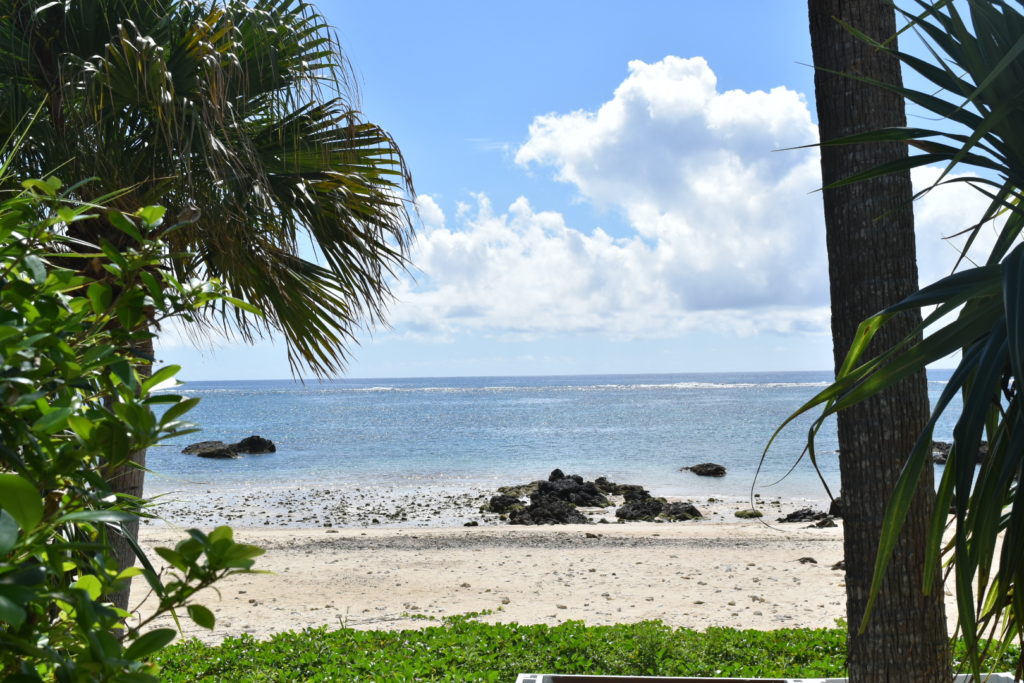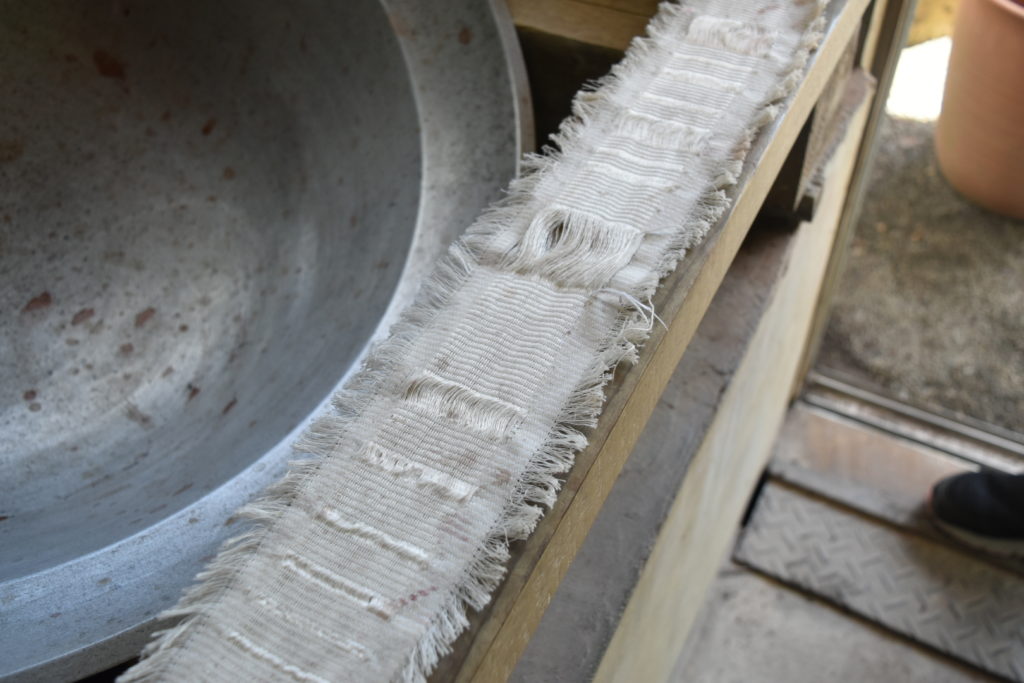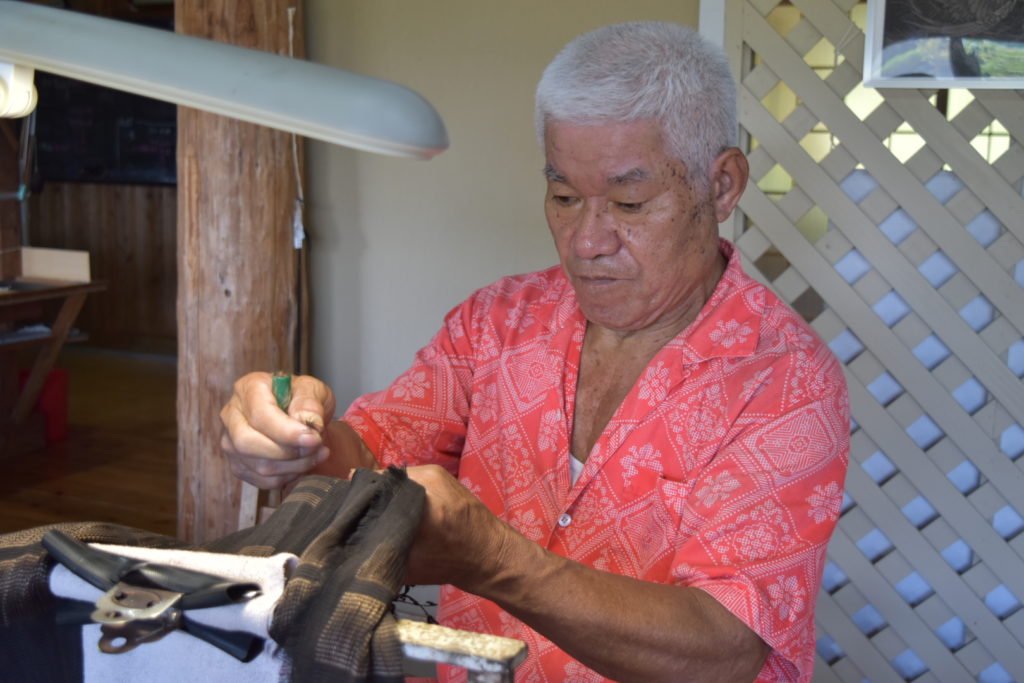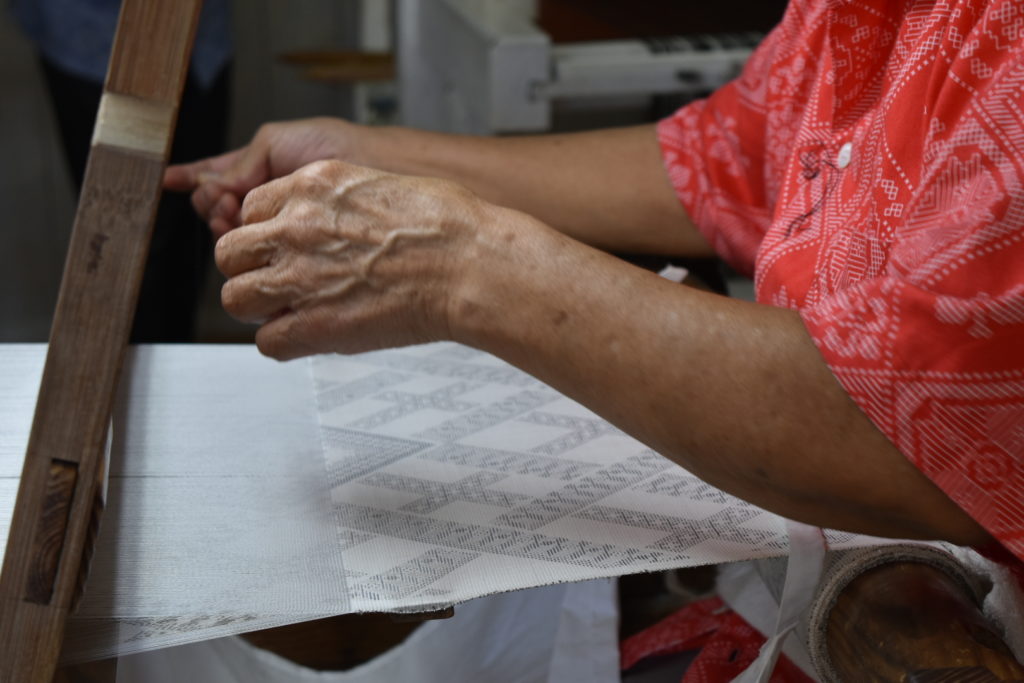OHSHIMA-TSUMUGI is the traditional woven fabric in AMAMI island KAGOSHIMA prefecture.
It’s made in AMAMI-OHSHIMA ISLAND.it’s located between OKINAWA and KAGOSHIMA.

AMAMI-OSHIMA has beautiful clear sea,it’s called ”ORIENTAL GARAPAGOS”in Japan.
And recently 26th July 2021, It has been registered as a WORLD NATURAL HERITAGE SITE.
OVERVIEW OF OSHIMA-TSUMUGI
- How to read : Oshima-tsumugi
- Birth place : Amami-Oshima (Kagoshima prefecture)
- Material : Silk 100%
- Dyeing method : Yarn dyeing
- Material(dying) : Sharinbai(Wheel plum) etc.
- Weave : Plain weave(hand loom)
Feature of OSHIMA-TSUMUGI
①Dyeing the threads before they’re woven is one of the features of Oshima Tsumugi. This dyeing method is called”SAKIZOME”.
At first, decide the rendering pattern ,and dye the yarn according to it.
Dyed threads are woven so that they overlap each dots. And then OSHIMA-TSUMUGI’S pattern is completed.
②DEEP JET-BLACK color is one of the features!
OSHIMA-TSUMUGI is dyed with wheel plum decoction and muddy water.
Turns jet black in reaction to iron contained in mud.
③OSHIMA TSUMUGI is the traditional kimono called ”QUEEN of KIMONO”in Japan.
It has a history of about 1300years,and It’s the three woven fabrics of the world along with Gobelin tapestry, Persian carpet.
Manufacturing process
Actually it has 30 process for manufacturing.I introduce main 6 process in this page.
- SHIMEBATA (締機) : weave the silk thread
- SHARINBAI ZOME(車輪梅染め) : Dye silk with the wheel plum decoction.
- DOROZOME(泥染め) : Dye the silk in muddy field.
- ZENKAI(全解) : Untie the cotton thread
- NASSEN(捺染) : Put colors to undyed part.
- TEBATA(手機) : Weave the dyeing threads.
1 SHIMEBATA : weave the silk thread
This process is advance preparation for dyeing threads.
Decide in advance the dyed part and undyed part. then it’s woven with silk and cotton threads.This cloth is woven with a silk weft on a cotton warp.This process is called ”shibori wo ireru”or”kasuri wo ireru”.Basically a male craftsman is in charge of this work because it requires pulling power.
SHIMEBATA is written in kanji as ”締機’’”締’’means pull something tight. ”機’means loom.


2 SHARINBAI ZOME : Dye silk part with the wheel plum decoction.
Dye the cloth (that is woven in shimebata process )with the WHEEL PLUM DECOCTION.
and then turn reddish brown!It’s called ”te-chi-gi zome”in the AMAMI dialect.WHEEL PLUM contains tannin.SHARINNBAI ZOME is written in kanji as ”車輪梅染め’’. ”車輪’’means whell.”梅’’means plum.”染め’’means dyeing.

Before the DOROZOME
3 DOROZOME : Dye the silk with muddy water.
Dye the cloth (that is dyed in sharinbai zome process )with the muddy watar.
Craftsman go to the mud field,and dye the cloth with muddy water.
AMAMI’s mud contains a lot of irons.Sharinbai’s tannins react with iron to turn black!
One set of SHARINBAI ZOME(20times) and DOROZOME(1times) ,repeat this set 4times……finally it become jet black color.
DOROZOME is written in kanji as ”泥染め’’. ”泥’means mud.”染め’’means dyeing.

4 ZENKAI : Untie the cotton thread
Untie the cotton threads of black cloth .
After the untie, It appears SILK threads(dyed part and undyed part)!
ZENKAI is written kanji ”全解’’.’’全’’means ALL.”解”means uniting.

5 NASSEN : Put colors to undyed part.
After untied cotton threads,she put colors to undyed white part as imaging pattern.
This process is called ”NASSEN”.”NASSEN” is written in kanji as ”捺染’’.”捺’’means press by hand.”染’’means dyeing.

Finally,THREADS are completed!(like this ↓)The texture is fluffy and soft.

6 TEBATA : Weave the dyeing threads.
Finally it will start the weaving process.This process is called ”TEBATA”.TEBATA is written in kanji ”手機”.’’手’’means hand.”機’’means loom(weaving machine)
Set the dyeing threads on the loom .And it is woven by craftsman who is called ”ORIKOU:織工’’.
She weave the threads a few centimeters adjusting to dots.It’s so delicate and persevering work.

Kind of OSHIMA-TSUMUGI
There are roughly divided into 4 kinds .
- DORO-OSHIMA(泥大島):traditional one.It’s woven with threads(DOROZOME and SGARINBAIZOME)
- AI-OSHIMA(藍大島) :It’s woven with threads (AIZOME and DOROZOME…)
- IRO-OSHIMA(色大島) :It’s woven with threads(DOROZOME and modern colors)
- SHIRO-OSHIMA(白大島):It’s woven with threads(dyeing by white mud)
There are some OHSHIMA-TSUMUGI . For example, KUSAKI-DOROZOME(草木泥染.) it’s dyed with plant or something expect SHARINBAI.



THIS EARTH SIGN is the AUTHENTIC OSHIMA-TSUMUGI!!
This is the definition of OSHIMA-TSUMUGI.
If the conditions are met ,it will be accepted as the authentic OSHIMA-TSUMUGI.
DEFINITION OF OSHIMA-TSUMUGI
- SILK 100%
- Yarn dyeing
- Plain weave
- use threads mede in the SHIMEBATA process
- weave threads as overlapping vertical and horizontal pattern.
IN OSHIMA-TSUMUGI ,there is the earth sign for each roll and the letter ”本場奄美大島’’.
Furthermore if the product inspction is cleard,the quality certificate label is affixed.This certificate is issued by association of OSHIMA-TSUMUGI.
This Earth sign comes with a wish of it’ll be a world class quality weaving.

THE PRESENT SITUATION OF OSHIMA-TSUMUGI.
As aging population has progressed, the number of craftsperson is decreasing.
Production is also declining.IN the heyday of the OSHIMATSUMUGI ,it produced 280,000 .but now 5,000.
I really hope that OSHIMA-TSUMIGI will be inherited to posterity.


